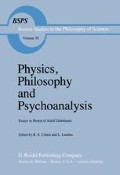Abstract
The mathematical structures associated with a space-time theory, such as the special theory of relativity (SRT) — or the general theory (GRT) for that matter — are numerous and interrelated in complex ways.1 One may start their analysis with the concept of a point set, the elements of which are identified with events in space-time.2 Imposing a continuity structure on this set leads to the concept of space-time as a four-dimensional topological manifold. Restriction to a differentiable structure then leads to the concept of space-time as a differentiable manifold. Various additional mathematical structures may now be introduced on this manifold: projective, affine, conformal and pseudo-metrical (a metrical structure with Minkowski signature). Each of these mathematical structures is closely associated with the behavior of some idealized physical entity in space-time. The projective structure is associated with the trajectories of structureless free test particles. If each particle carries some intrinsic measure of duration along its trajectory, it reflects the affine structure. The conformal structure is associated with the wave fronts of massless fields, such as the electromagnetic. A pseudo-metrical structure with Minkowski signature implies the existence of two fundamentally distinct types of interval which cannot be transformed into one another by any operation of the symmetry group defining the geometry (the inhomo- geneous Lorentz group for SRT).3 These two distinct types of interval are called spacelike and timelike, and physically quite distinct entities — measuring rods and clocks — are associated with their respective measurement.
Access this chapter
Tax calculation will be finalised at checkout
Purchases are for personal use only
Preview
Unable to display preview. Download preview PDF.
References
Berzi, V. and Gorini, V. 1969. ‘Reciprocity Principle and the Lorentz Transformations,’ J. Math Phys. 10, 1518–1524.
Carter, B. and Quintana, H. 1972. ‘Foundations of General Relativistic High-Pressure Elasticity Theory,’Proc. Roy. Soc. Lond. A 331, 57–83.
Dixon, W. G. 1978. Special Relativity: The Foundation of Macroscopic Physics. Cambridge: Cambridge University Press.
Dorling, J. 1976. ‘Special Relativity Out of Euclidean Geometry,’ unpublished.
Ehlers, J. 1973a. ‘The Nature and Structure of Spacetime.’ In J. Mehra (ed.), The Physicist’s Conception of Nature, pp. 71–91. Dordrecht and Boston: D. Reidel.
Ehlers, J. 1973b. ‘Survey of General Relativity Theory.’ In W. Israel (ed.), Relativity, Astrophysics and Cosmology, pp. 1–125. Dordrecht: D. Reidel.
Ehlers, J., Pirani, F. A. E., and Schild, A. 1972. The Geometry of Free Fall and Light Propagation.’ In L. O’Raifeartaigh (ed.), General Relativity. Oxford: Clarendon Press.
Einstein, A. 1905. Zur Elektrodynamik bewegter Körper,Ann. Phys. 17, 891–921.
Einstein, A. 1911. ‘Zum Ehrenfestchen Paradoxon,’Physik. Zeitschr.12, 509–510.
Einstein, A. 1954. ‘What Is the Theory of Relativity?’ In his Ideas and Opinions, pp. 227–232. New York: Crown.
Einstein, A. 1979. Autobiographical Notes: A Centennial Edition. LaSalle/Chicago: Open Court.
Feenberg, E. 1979. ‘Distant Synchrony and the One-Way Velocity of Light,’ Found, Phys. 9, 329–337.
Frank, P. and Rothe, H. 1911. Ueber die Transformation der Raumzeitkoordinaten von ruhenden auf bewegte System. Ann. der Phys. 34, 825–855.
Herglotz, G. 1911. Ueber die Mechanik des deformierbaren Korpers vom Standpunkte der Relativitatstheorie,Ann. Phys. 36, 493–533.
Ignatowsky, W. 1910. ‘Einige allgemeine Bemerkungen zum Relativitatsprinzip,’ Physik, Zeitschr. 10, 972–975.
Jammer, M. 1979. ‘Some Foundational Problems in the Special Theory of Relativity.’ In G. Toraldo di Francia (ed.), Problems in the Foundations of Physics, pp. 202–236. Amsterdam/New York/Oxford: North-Holland.
Lee, A. R. and Kalotas, T. M. 1975. ‘Lorentz Transformations from the First Postulate,’ Am. J. Phys. 43, 434–437.
Lévy-Leblond, J. M. 1976. ‘One More Derivation of the Lorentz Transformation,’ Am. J. Phys. 44, 271–277.
Minkowski, H. 1909. Raum und Zeit. Leipzig/Berlin: B. G. Teubner.
Pauli, W. 1958. Theory of Relativity. New York: Pergamon.
Pfarr, J. (ed.). 1981. Protophysik und Relativitatstheorie. Mannheim/Vienna/Zurich: B. I. Wissenschaftsverlag.
Poincaré, H. 1887. ‘Sur les hypothèses fondamentales de la géometric,’ Bull. Soc. Math. France 15, 203–216.
Poincaré, H. 1952. ‘Non-Euclidean Geometries.’ In his Science and Hypothesis, pp. 35–50. New York: Dover.
Robb, A. A. 1914. A Theory of Time and Space. Cambridge: Cambridge University Press.
Robb, A. A. 1921. The Absolute Relations of Time and Space. Cambridge: Cambridge University Press.
Robb, A. A. 1936. The Geometry of Space and Time. Cambridge: Cambridge University Press.
Schwartz, H. M. 1962. ‘Axiomatic Deduction of the General Lorentz Transformations,’ Am. J. Phys. 30, 697–707.
Soper, D. E. 1976. Classical Field Theory. New York: Wiley-Interscience.
Süssmann, G. 1969. ‘Begründung der Lorentz-Gruppe mit Symmetrie-und Relativitats-Annahmen,’ Zeitschr. Naturf. 24a, 495–498.
Synge, J. L. 1960. Relativity: The General Theory. Amsterdam: North-Holland.
Synge, J. L. 1964. Relativity: The Special Theory. 2nd ed. Amsterdam: North-Holland.
Weyl, H. 1923. Mathematische Analyse des Raumproblems. Berlin: Springer.
Author information
Authors and Affiliations
Editor information
Editors and Affiliations
Rights and permissions
Copyright information
© 1983 D. Reidel Publishing Company
About this chapter
Cite this chapter
Stachel, J. (1983). Special Relativity from Measuring Rods. In: Cohen, R.S., Laudan, L. (eds) Physics, Philosophy and Psychoanalysis. Boston Studies in the Philosophy of Science, vol 76. Springer, Dordrecht. https://doi.org/10.1007/978-94-009-7055-7_13
Download citation
DOI: https://doi.org/10.1007/978-94-009-7055-7_13
Publisher Name: Springer, Dordrecht
Print ISBN: 978-94-009-7057-1
Online ISBN: 978-94-009-7055-7
eBook Packages: Springer Book Archive

